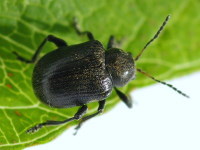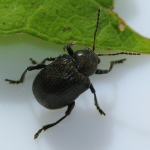Phylum Arthropoda (Arthropods) ➔ Subphylum Hexapoda (Hexapods) ➔ Class Insecta (Insects) ➔ Order Coleoptera (Beetles) ➔ Family Chrysomelidae (Leaf beetles)
Bromius obscurus (Linnaeus, 1758)
Weidenröschen-Blattkäfer Western Grape Rootworm
Synonyms and other combinations:
Chrysomela obscurus Linnaeus, 1758 [original combination] | Chrysomela nigroquadratus De Geer, 1775 | Chrysochus cochlearius Say, 1859 | Bromius japonicus Ohno, 1960 | Adoxus obscurus (Linnaeus, 1758) |
Classification:
Bromius obscurus belongs to the subfamily Eumolpinae, tribe Bromiini.Distribution:
Palearctic (Europe, Asia, North Africa); introduced to North America.Habitat:
Light forests, forest edges, tall perennial herb communities.Description:
Length 5 - 6 mm; body black, short haired; pronotum strongly arched, without lateral margin and densely dotted; elytra black or brown, wider than pronotum, parallel sided with distinctly pronounced shoulders, densely dotted with indicated rows of dots; antennae black with reddish base; middle and hind tibia in front of tip without tooth; claws completely split.Biology:
The Western Grape Rootworm Bromius obscurus is a parthenogenetic species in Europe. The offspring develop from unfertilized eggs. In North America there are also sexual forms.The adults of Bromius obscurus appear at the beginning of May and eat holes in the leaves of their host plants. They live mostly on Onagraceae and are often found on willowherbs (Epilobium), but also feed on other plants such as blackberries (Rubus) and grapevines (Vitis). The females start laying eggs after about 2 weeks. These are laid in small groups under bark or in other protected places. The larvae hatch after 8 - 12 days, dig into the soil and feed on the roots of their host plants. Bromius obscurus hibernates as a full-grown larva at greater depths in the soil, perhaps sometimes also as a pupa.
References, further reading, links:
- Rheinheimer, Joachim, & Hassler, Michael: Die Blattkäfer Baden-Württembergs, 2018, 928 pages, Kleinsteuber Books (Karlsruhe), ISBN 978-3-9818110-2-5
- Arved Lompe: Die Käfer Europas - Ein Bestimmungswerk im Internet
- Altica sp.
- Bruchus sp.
- Cassida nebulosa
- Cassida sp.
- Cassida stigmatica
- Cassida vibex
- Cassida vibex/bergeali
- Chrysolina lucidicollis
- Chrysolina oricalcia
- Chrysolina sp.
- Chrysolina sturmi
- Chrysolina varians
- Chrysomela tremula
- Coptocephala sp.
- Crepidodera aurea
- Crepidodera fulvicornis
- Cryptocephalus moraei
- Cryptocephalus nitidus
- Cryptocephalus pusillus
- Cryptocephalus sp.
- Donacia cinerea
- Donacia marginata
- Donacia versicolorea
- Galeruca tanaceti
- Galerucella s.l.
- Gonioctena decemnotata
- Gonioctena quinquepunctata
- Gonioctena sp.
- Gonioctena viminalis
- Lema cyanella
- Neocrepidodera sp.
- Oulema melanopus/duftschmidi
- Oulema obscura
- Pachybrachis sp.
- Phratora sp.
- Plagiosterna aenea
- Plateumaris sp.
- Podagrica fuscicornis
- Psylliodes sp.
- Sphaeroderma sp.
- Gonioctena quinquepunctata/intermedia
- Alder Leaf Beetle
- Ant Bag Beetle
- Barley Flea Beetle
- Brassy Willow Leaf Beetle
- Broad Bean Weevil
- Case-bearing Leaf Beetles
- Colorado Potato Beetle
- Dead-nettle Leaf Beetle
- Elm Leaf Beetle
- Four Spotted Leaf Beetle
- Green Dock Beetle
- Green Tortoise Beetle
- Horseradish Flea Beetle
- Imported Willow Leaf Beetle
- Iris Flea Beetle
- Lily Leaf Beetle
- Plantain Leaf Beetle
- Poplar Leaf Beetle
- Skullcap Leaf Beetle
- Spotted Asparagus Beetle
- Spotted Willow Leaf Beetle
- St John's-wort Leaf Beetle
- Thistle Tortoise Beetle
- Turnip Flea Beetle
- Two-tone Reed Beetle
- Viburnum Leaf Beetle
- Western Grape Rootworm
- Wheat Flea Beetle
- Willow Flea Beetle
- Willow Leaf Beetle


